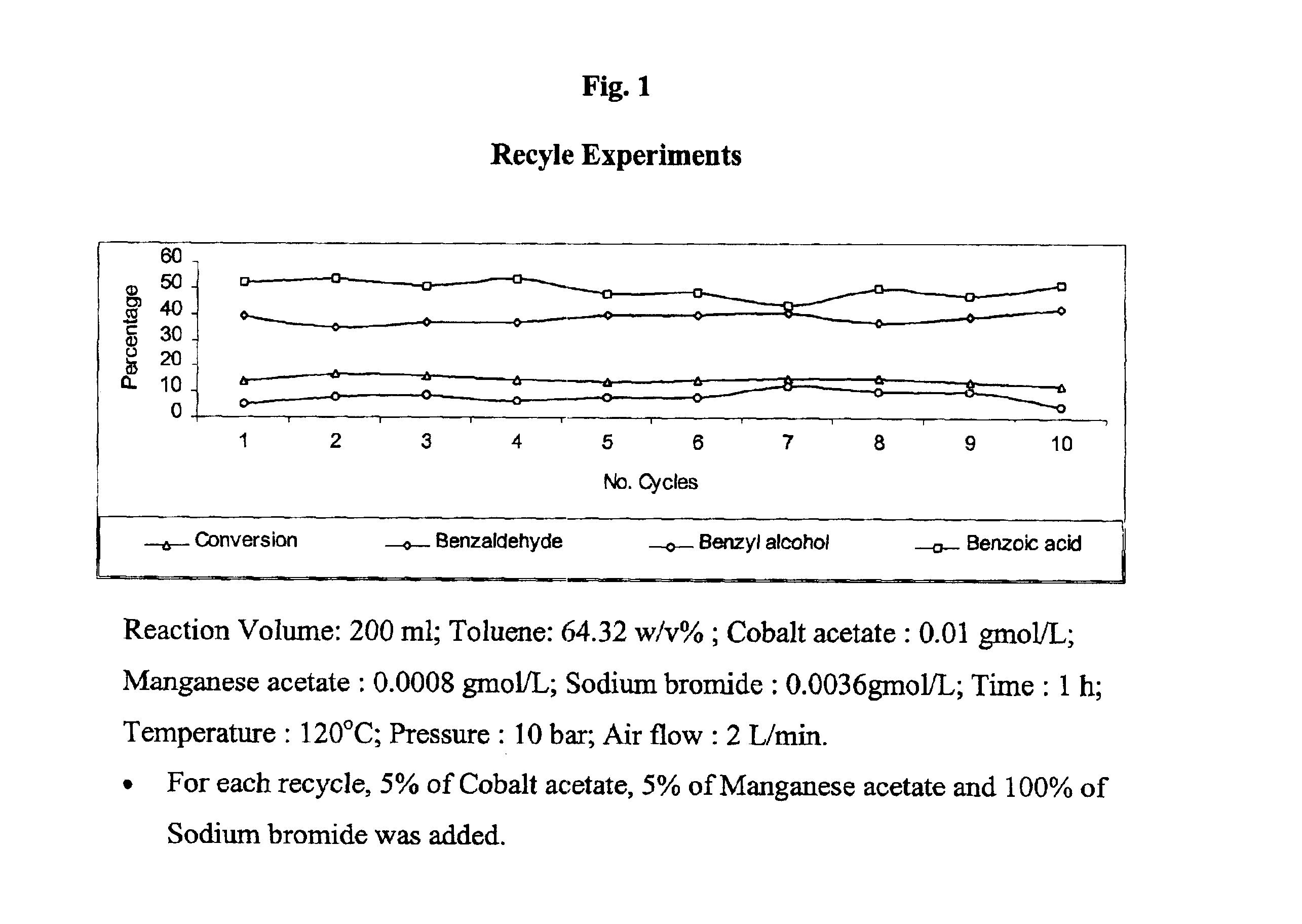Selective liquid phase air oxidation of toluene catalysed by composite catalytic system
a composite catalytic system and liquid phase air technology, applied in the direction of carbonyl compound preparation by oxidation, carboxylic compound preparation, carbonyl compound preparation, etc., can solve the problems of large excess of effluent generation, benzaldehyde produced does not meet food grade specifications, and recovery problems
- Summary
- Abstract
- Description
- Claims
- Application Information
AI Technical Summary
Benefits of technology
Problems solved by technology
Method used
Image
Examples
example 1
Buchi glass autoclave of 500 ml capacity equipped with a gas connecting tube, stirrer, temperature indicator and pressure gauge was deployed. The following materials were taken in the reaction vessel: 225 ml toluene, 75 ml of acetic acid, and 1.50 g of cobalt acetate, 0.09 g of manganese acetate.4 water salt, 2.7 g of zinc bromide. After flushing with air three times, the solution was heated slowly up to 110.degree. C. while stirring the reaction mixture. After system attained a constant temperature of 110.degree. C., it was pressurised with air to 10 bar with 2 L / min out flow. After 1:15 hrs, the reaction mixture was taken out. Gas chromatographic and titrimetric analysis on the product indicates conversion of 14.04% with selectivity of 42.3% benzaldehyde, 4.98% benzyl alcohol and 52.72% benzoic acid.
example 2
Buchi glass autoclave of 250 ml capacity equipped with a gas connecting tube, stirrer, temperature indicator and pressure gauge was deployed. The following materials were taken in the reaction vessel: 150 ml of toluene, 50 ml of acetic acid, and 0.5 g of cobalt acetate 4 water salt, 0.04 g of manganese acetate.4 water salt, 0.66 g of zinc bromide. After flushing with air three times, the solution was heated slowly up to 110.degree. C. while stirring the reaction mixture. After system attained a constant temperature of 110.degree. C., it was pressurised with air to 10 bar with 2 L / min out flow. After 1:15 hrs, the reaction mixture was taken out. Gas chromatographic and titrimetric analysis on the product indicates conversion of 15.78% with selectivity of 36.59% benzaldehyde, 6.04% benzyl alcohol and 57.37% benzoic acid.
example 3
Buchi glass autoclave of 250 ml capacity equipped with a gas connecting tube, stirrer, temperature indicator and pressure gauge was deployed. The following materials were taken in the reaction vessel: 150 ml of toluene, 50 ml of acetic acid, and 0.5 g of cobalt acetate.4 water salt, 0.04 g of manganese acetate.4 water salt, 0.106 g of sodium bromide, 0.314 g of sodium chloride. After flushing with air three times, the solution was heated slowly up to 110.degree. C. while stirring the reaction mixture. After system attained a constant temperature of 110.degree. C., it was pressurised with air to 10 bar with 2 L / min out flow. After 1:15 hrs, the reaction mixture was taken out. Gas chromatographic and titrimetric analysis on the product indicates conversion of 14.34% with selectivity of 42.61% benzaldehyde, 3.83% benzyl alcohol and 53.56% benzoic acid.
PUM
| Property | Measurement | Unit |
|---|---|---|
| pressure | aaaaa | aaaaa |
| temperature | aaaaa | aaaaa |
| temperatures | aaaaa | aaaaa |
Abstract
Description
Claims
Application Information
 Login to View More
Login to View More - R&D
- Intellectual Property
- Life Sciences
- Materials
- Tech Scout
- Unparalleled Data Quality
- Higher Quality Content
- 60% Fewer Hallucinations
Browse by: Latest US Patents, China's latest patents, Technical Efficacy Thesaurus, Application Domain, Technology Topic, Popular Technical Reports.
© 2025 PatSnap. All rights reserved.Legal|Privacy policy|Modern Slavery Act Transparency Statement|Sitemap|About US| Contact US: help@patsnap.com

